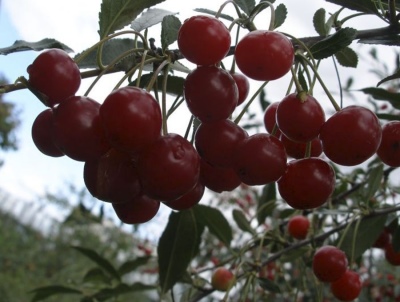
- Authors: N.I. Gvozdyukova, M.G. Isakova, S.V. Zhukov (Sverdlovsk Horticultural Selection Station)
- Year of approval: 1992
- Barrel type: bush
- Growth type: medium-sized
- Crown: compact, round-oval, medium density
- Foliage: thick
- Leaves: narrow oval, dark green
- Flowers: white, goblet
- Flowering and fruiting type: on bouquet branches and annual growth
- Fruit size: small
If there is not much space on the personal plot, but you really want to plant a cherry tree, then there is a way out - Cherry Abundant. In addition to its compact size, it is also frost-resistant and high-yielding, which can please not only gardeners, but also farmers.
Breeding history
The variety originates in the distant 80s of the XX century, when the Sverdlovsk selection experimental gardening station, represented by its employees Zhukov, Gvozdyukova and Isakova, took up the development of culture. The specialists took seedlings from free pollination of Michurin varieties as a basis. As a result of selection selection, a variety was created that is distinguished by excellent winter hardiness and small size. State variety testing has been carried out since 1988. And in 1992, the culture was enrolled in the State Register and zoned for the Volgo-Vyatka (Sverdlovsk region) and Ural regions. But the variety fell in love with all gardeners, and the cherry has spread much wider than the indicated territories, almost throughout the country.
Description of the variety
Abundant is a steppe cherry species that develops in the form of a medium-sized bush 2.5-3 m in size. It has a rather compact rounded-oval crown. Crown density and foliage are average. Fruiting on bouquet shoots and 1-year growth. Differs in late flowering with white goblet flowers. Blooms from May 30 to June 8.
Fruit characteristics
Cherry fruits are small, from 2.5 to 3 grams. Rounded, dark red. Moreover, not only the skin is red, but also the pulp. The stone is dressed medium, the separation is dry.
Taste qualities
Abundant has a very good sweet and sour taste. The cherry juice is pink. Universal fruits can be eaten fresh, used in winter preparations: compotes, jams, preserves. A very aromatic homemade wine is obtained from the cherry varieties. Fruit taste score - 3.8 points.
Ripening and fruiting
The culture is distinguished by its late ripening period. The beginning of fruiting is the 2nd decade of August, the cherries do not ripen at the same time. The early maturity is average - 3-4 years after disembarkation. Bears fruit regularly. Plants have a lifespan of over 30 years.

Yield
The yield is noted as high. At the same time, the volume of the harvest increases with each next year. The maximum number of cherries Abundant can bring for 8-10 years.
Landing
Considering the late entry into the growing season, it is advisable to plant Izobilnaya cherry in the spring. It is optimal to do this in April, when the ground thaws enough, and the seedlings themselves are at rest.
When choosing a place to plant Izobilnaya, it is important to consider a number of factors:
- the site must be open, well-lit by the rays of the sun;
- from the cold wind, on the contrary, you need shelter;
- it is not recommended to plant cherries where any fruit trees used to grow.


Growing and care
Cherry Abundant requires increased attention at a young age. For an already adult plant, care is simple.
So, immediately after planting and for the entire 1 year, the Izobilnaya sapling will need weekly watering. In the rainy season, you can, of course, reduce the frequency of watering. From the age of 2, irrigation will not be an obligatory procedure - the culture is drought-resistant.
Formation of Cherry Abundant should be carried out rather moderately, since cardinal pruning will become stressful for it, it may even destroy it. So, for the first 6 years, it is recommended to carry out only sanitary pruning: in the fall, after the leaves fall off, you can remove dried or damaged, as well as diseased branches. The care measures include the removal of new growth that grows at the roots. When the tree is over 8-10 years old, rejuvenating pruning is performed.
If cherries are planted in fertile soil, for example, black soil, then fertilizers should be applied from 4 years after planting. The cherry tree will have enough nutrients from the soil, as well as those dressings that were laid in the planting hole. A culture growing in depleted areas will need to be fed from 2 years after planting.


Disease and pest resistance
Cherry Abundant has an average resistance to diseases and pest attacks. Most often she can suffer from coccomycosis and moniliosis.
Requirements for soil and climatic conditions
The winter hardiness of the crop is very high. And due to the fact that cherry blossoms are late, Abundant is not susceptible to spring frosts. And also the variety is drought-resistant.
































































